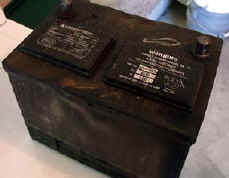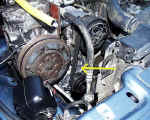UPGRADING YOUR ELECTRICAL SYSTEM TO SUPPORT HIGH-AMPERAGE ACCESSORIES
PART ONE - AUTOMOTIVE ELECTRICAL 101
 I have wheeled the Rubicon twice
in the last four weeks and noticed, though it was nothing new, that
most of the 4x4’s also being driven had a winch, auxiliary
lighting, or both. These accessories serve several purposes in the
off-road world, most notably, safety. Winches help gut us unstuck,
and secure our vehicles when the pucker factor begins to overwhelm.
Driving lights, fog lights, off-road lights, rock lights, back up
lights, northern lights, porch lights…we cover our vehicles
with them.
I have wheeled the Rubicon twice
in the last four weeks and noticed, though it was nothing new, that
most of the 4x4’s also being driven had a winch, auxiliary
lighting, or both. These accessories serve several purposes in the
off-road world, most notably, safety. Winches help gut us unstuck,
and secure our vehicles when the pucker factor begins to overwhelm.
Driving lights, fog lights, off-road lights, rock lights, back up
lights, northern lights, porch lights…we cover our vehicles
with them.What do these modifications have in common? They all tax your electrical system heavily. What do 4x4’s that have these accessories have in common? Many are not equipped to deliver the power and current these items need to function safely and correctly. What can you do to remedy this situation? Upgrade! (What else did you expect?)
Electrical System Basics
Your 4x4’s 12 volt electrical system, while simple to understand, is actually quite ingenious in design.
The first component in the system is the battery. The battery is used to store power for starting, and for running auxiliary devices such as radios and lighting when the engine is off. The next major component is the starter, which is used to start the engine. The third component is the alternator. It powers the electrical system when the car is running, and restores the battery charge. With these basic components, the vehicle maintains its supply of electricity. A voltage regulator keeps the power level stabilized, and the fuse box keeps minor problems from becoming major headaches.
Battery
 The car's initial source of
electricity is a battery, whose most important function is to start
the engine. Once the engine is running, an alternator takes over to
supply the car's electrical needs and to restore energy to the
battery. This may make you ask, "Why do I need a high-capacity
battery if the alternator is doing all the work?". Most often it is
because the stereo or auxiliary lighting is left on while the
vehicle is turned off.
The car's initial source of
electricity is a battery, whose most important function is to start
the engine. Once the engine is running, an alternator takes over to
supply the car's electrical needs and to restore energy to the
battery. This may make you ask, "Why do I need a high-capacity
battery if the alternator is doing all the work?". Most often it is
because the stereo or auxiliary lighting is left on while the
vehicle is turned off.The batteries store usable electrical energy, and this reserve of energy is slowly drained while it is not being recharged by the alternator. How fast the battery discharges depends on how many amps are being drawn, and the length of time those amps are draining. Of course, the end result of running those lights or radio too long is a dead battery. For this reason, the more reserve capacity your battery has, the longer you can use these accessories. This gives you a perfect reason to either upgrade your stock battery to a heavy duty version, or better yet, to dual heavy duty batteries.
A 12-volt storage battery consists of layers of positively and negatively charged lead plates that, together with their insulated separators, make up each of six two-volt cells. The cells are filled with an electricity-conducting liquid (electrolyte) that is usually two-thirds distilled water and one-third sulfuric acid. Spaces between the immersed plates provide the most exposure to the electrolyte. The interaction of the plates and the electrolyte produces chemical energy that becomes electricity when a circuit is formed between the negative and positive battery terminals.
Types of Batteries
There are four types of batteries suited for use in automotive applications:
|
Automotive
Starting Batteries It has one job only: to start your car. An average car uses more than 300 amps for a few seconds in order to start. The batteries are constructed with a large number of thin plates of lead sponge. The expected lifetime of a starting battery in true starting use is 3-5 years. In deep-cycle service, expect less than 2 years. |
Low Antimony
Deep Cycle Batteries These are run-of-the-mill "marine/RV deep-cycle" batteries. It's a compromise between a starting battery and a true deep-cycle battery. They are much closer to starting batteries, however. If cycled 80%, expect a lifetime of less than 200 cycles, or about the same as the starting battery. |
|
High Antimony
Deep Cycle Batteries This type is designed to be 80% cycled repeatedly for 5-15 years. There is almost no mechanical similarity between this battery and a starting battery. They are massive and huge. A 350 amp-hr 12 volt battery weighs 250 pounds and contains 4.5 gallons of sulfuric acid. Lifetime should be 5-15 years. |
Gel
Cells This type is designed for portability. They are small and have a jellied electrolyte. The case is sealed. The jellied electrolyte allows the use of this battery in any orientation. With proper care, a gel-cell will deliver 1000 cycles over a period of 5 years or more. |
Ever wonder just what a cold cranking amp rating is? It refers to the number of amps a battery can support for 30 seconds at a temperature of 0°F until the battery voltage drops to 1.20V per cell (7.20V for a 12V battery).
Starter
The starter converts electricity to mechanical energy in two stages. Turning on the ignition switch releases a small amount of power from the battery to the solenoid above the starter. This creates a magnetic field that pulls the solenoid plunger forward, forcing the attached shift yoke to move the starter drive so that its pinion gear meshes with the engine's crankshaft flywheel. When the plunger completes its travels, it strikes a contact that permits a greater amount of current to flow from the battery to the starter motor. The motor then spins the drive and turns the meshed gears to provide power to the crankshaft, which prepares each cylinder for ignition. After the engine starts, the ignition key is released to break the starting circuit. The solenoid's magnetic field collapses and the return spring pulls the plunger back, automatically shutting off the starter motor and disengaging the starter drive.Alternator
 The alternating-current generator, or alternator, is the
electrical system's chief source of power while the engine is
running. Its shaft is driven by the same belt that spins the fan.
It converts mechanical energy into alternating-current electricity,
which is then channeled through diodes that alter it to direct
current for the electrical system and for recharging the
battery.
The alternating-current generator, or alternator, is the
electrical system's chief source of power while the engine is
running. Its shaft is driven by the same belt that spins the fan.
It converts mechanical energy into alternating-current electricity,
which is then channeled through diodes that alter it to direct
current for the electrical system and for recharging the
battery.Is your Alternator big enough for all your electrical equipment? If you have a large stereo system you’ll know that it is not when the bass thumps…you may see your headlights and dash lights dim. Each 100 watt lamp is going to draw about 9 amps so six of them is going to suck up about 55 Amps. The other accessories on your car - cooling fan, heater fan, ignition, fuel pump, running lights, etc. - are going to draw roughly another 30-40 Amps - your total power requirement will reach about 90-100 Amps. Add more lights, a large stereo system, a winch, and you may find yourself with an overworked alternator.
It's impossible to compensate for a small alternator by throwing in a bigger battery as the battery will just be drained and the voltage will suffer, affecting your light output and overall performance. Your best solution is to go to a modern, high output alternator of at least 100 Amps or more. If you are really worried about weight, you're better off with a smaller battery. All it really has to do is start the engine if the alternator is large enough to carry the rest of the load after the car is running.
Follow @Off-Road


 Your Privacy Choices
Your Privacy Choices